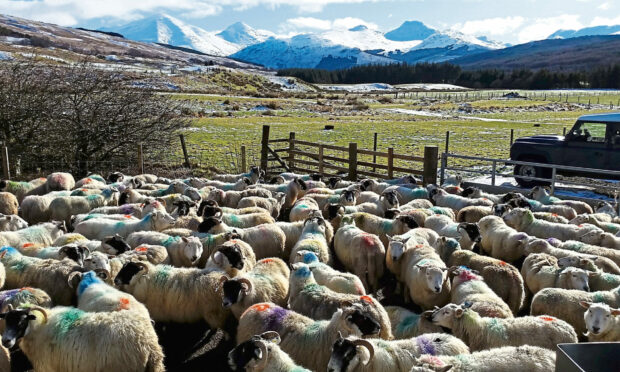A breeding programme which focuses on characteristics strongly influenced by genetics can be a powerful tool to increase production in sheep flocks.
And if we were down in the lowlands, we would be selecting our breeding stock primarily on how well their lambs grow and perform.
But in a harsh hill environment it is just as important to ensure that a ewe can support herself and thereby make certain that she is fit and healthy enough to raise a lamb through to weaning.
That means there is a need to focus on the characteristics of the ewe as well as on how well her offspring might do.
We have been conducting selective breeding within our Kirkton sheep flock on the farms for more than 20 years.
And we have shown that it provides clear and measurable production benefits when compared to individuals selected purely on how they look.
For example, we have increased overall profitability of our high genetic selection Scottish Blackface ewes by between £3 and £5 per ewe per year when compared to the other Blackface ewes running within the same flock.
But we are all operating within a different environment now.
One where increased income will not be all that is required from future hill sheep flocks if they are to be fully sustainable.
And unfortunately, the improvements we have achieved in profitability have also come at the expense of increased greenhouse gas emissions.
Breeding ewes and greenhouse gas emissions
The lambs from the high selection ewes do grow better and finish faster and hence the emissions per kilogram of meat associated with them are lower over the eight to nine months from birth to slaughter.
However, the high selection breeding ewes have increased in mature size by around 3kg when compared to the other ewes in the flock.
And as breeding ewes are on the farms for years, this means the savings in emissions from their lambs through to slaughter each year are offset by the increase in emissions from these larger ewes.
So thanks to funding from the Scottish Government, we are now refocusing the breeding programme to investigate whether it is possible to select for productive ewes, capable of using hill grazing efficiently, but which have less environmental impact.
We’ll therefore be comparing and contrasting the performance of our high selection Scottish Blackface ewes and lambs with crossbred ewes and their offspring.
To this end, we are combining genetics from Blackface and Lleyn in our crossbred ewes – because we already know a lot about their genetic performance and they show substantial genetic variation in the characteristics that we want to improve.
Trade-offs and win-wins with breeding programme
We will be recording some of the same characteristics we have investigated in the past.
For example, ewe longevity, lamb survival, health and welfare of ewes and lambs, and of course production and product quality characteristics.
But we already know there are differences within and between breeds with regard to the amount of individual feed intake and feed efficiency – the growth relative to the amount of feed eaten.
We also know that hill breeds have larger rumens to help them digest poorer quality, more fibrous forage on the hill. But also that larger rumens can result in higher methane emissions.
So the feed efficiency equipment we already have, together with SRUC’s mobile CT scanner, will be essential tools that we will use for this research.
Focusing on feed efficiency and developing predictors of greenhouse gas emissions – both at the level of the individual animal – will help us identify the range of trade-offs and win-wins associated with our new breeding programme.











Conversation